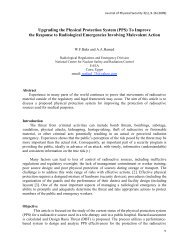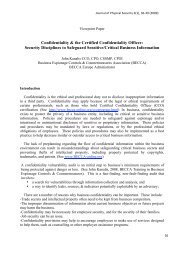PDF - The Journal of Physical Security - Argonne National Laboratory
PDF - The Journal of Physical Security - Argonne National Laboratory
PDF - The Journal of Physical Security - Argonne National Laboratory
You also want an ePaper? Increase the reach of your titles
YUMPU automatically turns print PDFs into web optimized ePapers that Google loves.
<strong>Journal</strong> <strong>of</strong> <strong>Physical</strong> <strong>Security</strong> 4(2), 10-29 (2010)1. IntroductionDifferent scenarios can be envisioned that would be relevant to the design <strong>of</strong> terrorist mitigation measuresat a facility. For explosive threats, one could assume a scenario in which the stand<strong>of</strong>f distance is theminimum possible distance to the intended target, produces collateral damage to nearby facilities and thatthe explosive source is very large. For example, one such scenario might be 40,000 lb <strong>of</strong> an efficientlyexploded ammonium nitrate/fuel oil mixture contained within an 18-wheeler. A related scenario might bewhere the 18-wheeler is located as close as physically possible to the intended target or where the size <strong>of</strong>the explosive source is not as large. If a smaller vehicle is envisioned to transport the source, 40,000 lbwould be an overestimate <strong>of</strong> the explosive payload. In addition, the TNT-equivalent mass <strong>of</strong> theexplosive can vary depending on the physical and chemical details <strong>of</strong> the explosive mixture.<strong>The</strong> uncertainties in explosive strength and stand<strong>of</strong>f distance suggest that a statistical assessment <strong>of</strong> thethreat parameters could play a role in the mitigation design. This type <strong>of</strong> approach has been pr<strong>of</strong>feredrecently by Stewart, Netherton, and Rosowsky (2006). In this reference they argue that there is so muchuncertainty associated with terrorism that an attempt should be made to quantify the uncertainties, andthat these results should then be used in established probabilistic risk assessment procedures tosystematically assess the viability and relative benefits <strong>of</strong> different mitigation measures.Netherton and Stewart (2009) considered the variability in explosive blast loading caused by amultiplicity <strong>of</strong> factors with respect to façade glazing, and used Monte Carlo simulation to calculateprobabilities <strong>of</strong> glazing damage and safety hazards conditional on scenario-driven parameters.<strong>The</strong> present paper also provides a statistical assessment <strong>of</strong> an explosive-borne threat to window structuresin facilities. However, we adopt an exclusively analytic approach based on published scaling relations forthe key explosive parameters, impulse and overpressure, as well as the design specifications <strong>of</strong> thewindow. Although it does not take into consideration every physical parameter that affects explosiveimpact (most notably the presence <strong>of</strong> intervening structures), this method obviates the need for computersimulation and yields a simple if approximate method to assess explosive risk.Specifically, we estimate the probability <strong>of</strong> protection one might expect against likely blast overpressuresand impulses. This is based on both the probability function for explosive strength and stand<strong>of</strong>f distanceand the design curve used for constructing components <strong>of</strong> a curtain wall façade, a popular form <strong>of</strong>construction for modern <strong>of</strong>fice facilities. In this paper, the design curve is derived from a simple singledegree <strong>of</strong> freedom (SDOF) component model.In addition, the method <strong>of</strong> assessing the probability <strong>of</strong> protection afforded by a specific buildingcomponent as described herein can be generalized and applied to other security scenarios for whichscaling relations exist for relevant physical parameters. This <strong>of</strong>fers a potentially powerful tool inquantitatively assessing risk for a variety <strong>of</strong> scenarios.Section 2 describes the probability distributions to be assumed for the TNT equivalence strength <strong>of</strong> theexplosive source, and for the stand<strong>of</strong>f distance between the explosive source and a potential target.Section 3 discusses the blast parameters (overpressure and impulse) that determine the damageexperienced by a structure.Section 4 summarizes scaling laws that relate the blast overpressure and impulse to the explosive strengthand stand<strong>of</strong>f distance.11





